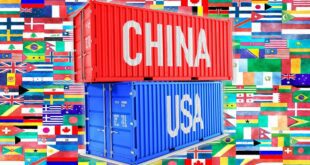A major portion of the U.S. dollar’s valuation stems from its lock on the oil industry and if it loses its position as the global reserve currency the value of the dollar will decline and gold will rise. Iran’s migration to a non-dollar based international trade system is the testing of the waters of a non-USD regime…transition to a world in which the U.S. Dollar suddenly finds itself irrelvant. [Let me explain.] Words: 1200
So says Marin Katusa (www.caseyresearch.com) in edited excerpts from the original article*.
Lorimer Wilson, editor of www.munKNEE.com has edited ([ ]), abridged (…) and reformatted (some sub-titles and bold/italics emphases) below for the sake of clarity and brevity to ensure a fast and easy read. The article’s views and conclusions are unaltered and no personal comments have been included to maintain the integrity of the original article. Please note that this paragraph must be included in any article re-posting to avoid copyright infringement.
Katusa goes on to say, in part:
The Abuse of the USD Status
A 1970s deal cemented the U.S. dollar as the only currency to buy and sell crude oil, and from that monopoly on the all-important oil trade the U.S. dollar slowly but surely became the reserve currency for global trades in most commodities and goods. Massive demand for US dollars ensued, pushing the dollar’s value up, up, and away. In addition, countries stored their excess US dollars savings in US Treasuries, giving the U.S. government a vast pool of credit from which to draw.
The above led to the government [becoming] suffocated by debt with its citizens facing high unemployment (due in part to the high value of the dollar); a failed real estate market; record personal-debt burdens; a bloated banking system; and a teetering economy. That is not the picture of a world superpower worthy of the privileges gained from having its currency back global trade. Other countries are starting to see that and are slowly but surely moving away from US dollars in their transactions, starting with oil.
The Development of the U.S. “Petrodollar” System
To explain this situation properly, we have to start in 1973. That’s when President Nixon asked King Faisal of Saudi Arabia to accept only US dollars as payment for oil and to invest any excess profits in US Treasury bonds, notes, and bills. In exchange, Nixon pledged to protect Saudi Arabian oil fields from the Soviet Union and other interested nations, such as Iran and Iraq. It was the start of something great for the U.S., even if the outcome was as artificial as the U.S. real-estate bubble and yet constitutes the foundation for the valuation of the U.S. dollar.
By 1975, all of the members of OPEC agreed to sell their oil only in US dollars. Every oil-importing nation in the world started saving its surplus in US dollars so as to be able to buy oil; with such high demand for dollars the currency strengthened. On top of that, many oil-exporting nations like Saudi Arabia spent their US dollar surpluses on Treasury securities, providing a new, deep pool of lenders to support US government spending.
The “petrodollar” system was a brilliant political and economic move. It forced the world’s oil money to flow through the U.S. Federal Reserve, creating ever-growing international demand for both US dollars and US debt, while essentially letting the U.S. pretty much own the world’s oil for free, since oil’s value is denominated in a currency that America controls and prints. The petrodollar system spread beyond oil: the majority of international trade is done in US dollars. That means that from Russia to China, Brazil to South Korea, every country aims to maximize the U.S.-dollar surplus garnered from its export trade to buy oil.
The U.S. has reaped many rewards:
- as oil usage increased in the 1980s, demand for the U.S. dollar rose with it, lifting the U.S. economy to new heights;
- the petrodollar system created consistent international demand for US dollars, which in turn gained in value;
- a strong US dollar allowed Americans to buy imported goods at a massive discount – the petrodollar system essentially creating a subsidy for U. consumers at the expense of the rest of the world.
- the availability of cheap imports hit the U.S. manufacturing industry hard and
- if the oil trade shifts to a currency other than the USD then countries around the world won’t need our money and the resultant sell-off of US dollars would weaken the currency dramatically.
U.S. Has Gone to Great Lengths to Protect its “Petrodollar”
Here’s an interesting thought experiment. Everybody says the U.S. goes to war to protect its oil supplies, but doesn’t it really go to war to ensure the continuation of the petrodollar system?
The Iraq war provides a good example. Until November 2000, no OPEC country had dared to violate the U.S. dollar-pricing rule, and while the U.S. dollar remained the strongest currency in the world there was also little reason to challenge the system. In late 2000, however, France and a few other EU members convinced Saddam Hussein to defy the petrodollar process and sell Iraq’s oil for food in euros, not dollars. In the time between then and the March 2003 American invasion of Iraq, several other nations hinted at their interest in non-US dollar oil trading, including Russia, Iran, Indonesia, and even Venezuela. In April 2002, Iranian OPEC representative Javad Yarjani was invited to Spain by the EU to deliver a detailed analysis of how OPEC might at some point sell its oil to the EU for euros, not dollars.
This movement, founded in Iraq, was starting to threaten the dominance of the U.S. dollar as the global reserve currency and petro currency. In March 2003, the U.S. invaded Iraq, ending the oil-for-food program and its euro payment program.
There are many other historic examples of the U.S. stepping in to halt a movement away from the petrodollar system, often in covert ways. In February 2011, Dominique Strauss-Kahn, managing director of the International Monetary Fund (IMF), called for a new world currency to challenge the dominance of the U.S. dollar. Three months later a maid at the Sofitel New York Hotel alleged that Strauss-Kahn sexually assaulted her. Strauss-Kahn was forced out of his role at the IMF within weeks; he has since been cleared of any wrongdoing.
War and insidious interventions of this sort may be costly, but the costs of not protecting the petrodollar system would be far higher. If euros, yen, renminbi, rubles, or for that matter straight gold, were generally accepted for oil, the U.S. dollar would quickly become irrelevant, rendering the currency almost worthless. As the rest of the world realizes that there are other options besides the U.S. dollar for global transactions, the U.S. is facing a very significant – and very messy – transition in the global oil machine.
Iran and US “Petrodollars”
The official line from the United States and the European Union is that Tehran must be punished for continuing its efforts to develop a nuclear weapon. The punishment is sanctions on Iran’s oil exports, which are meant to isolate Iran and depress the value of its currency to such a point that the country crumbles, but that line doesn’t make sense, and the sanctions will not achieve their goals…
Iran may be isolated from the United States and Western Europe, but Tehran still has some pretty staunch allies:
- Venezuela and Iran are advancing $4 billion worth of joint projects, including a bank.
- India has pledged to continue buying Iranian oil because Tehran has been a great business partner for New Delhi, which struggles to make its payments.
- Greece opposed the EU sanctions because Iran was one of very few suppliers that had been letting the bankrupt Greeks buy oil on credit.
- South Korea and Japan are pleading for exemptions from the coming embargoes because they rely on Iranian oil.
- Economic ties between Russia and Iran are getting stronger every year.
- Iran’s energy resources are a matter of national security for China, as Iran already supplies no less than 15% of China’s oil and natural gas. That makes Iran more important to China than Saudi Arabia is to the United States. Don’t expect China to heed the U.S. and EU sanctions much – China will find a way around the sanctions in order to protect two-way trade between the nations, which currently stands at $30 billion and is expected to hit $50 billion in 2015. In fact, China will probably gain from the U.S. and EU sanctions on Iran, as it will be able to buy oil and gas from Iran at depressed prices.
So Iran will continue to have friends, and those friends will continue to buy its oil. More importantly, you can bet they won’t be paying for that oil with US dollars.
- Rumors are swirling that India and Iran are at the negotiating table right now, hammering out a deal to trade oil for gold, supported by a few rupees and some yen.
- Iran is already dumping the dollar in its trade with Russia in favor of rials and rubles.
- India is already using the yuan with China;
- China and Russia have been trading in rubles and yuan for more than a year; [Read: Will the Trickle Out of the U.S. Dollar Now Become a Torrent?]
- Japan and China are moving towards transactions in yen and yuan and
- all those energy trades between Iran and China? That will be settled in gold, yuan, and rial.
With the Europeans out of the mix, in short order none of Iran’s 2.4 million barrels of oil a day will be traded in petrodollars. With all this knowledge in hand, it starts to seem pretty reasonable that the real reason tensions are mounting in the Persian Gulf is because the United States is desperate to torpedo this movement away from petrodollars. The shift is being spearheaded by Iran and backed by India, China, and Russia. That is undoubtedly enough to make Washington anxious enough to seek out an excuse to topple the regime in Iran…
Gold – The Fallback Currency
There is another consideration to keep in mind, one that is very important when it comes to making some investment decisions based on this situation: Russia, India, and China – three members of the rising economic powerhouse group known as the BRICs (which also includes Brazil) – are allied with Iran and are major gold producers. If petrodollars go out of vogue and trading in other currencies gets too complicated, they will tap their gold storehouses to keep the crude flowing. Gold always has, and always will be, the fallback currency and, as mentioned before, when currency relationships start to change and valuations become hard to predict, trading in gold is a tried and true failsafe.
2013 – The Beginning of the End for the Petrodollar?
2012 might end up being most famous as the year in which the world defected from the U.S. dollar as the global currency of choice. Imagine the rest of the world doing the math and, little by little, beginning to do business in their own currencies and investing ever less of their surpluses in US Treasuries. It constitutes nothing less than a slow but sure decimation of the dollar – which may not be a bad thing for the United States.
The country’s gargantuan debts can never be repaid as long as the dollar maintains anything close to its current valuation. Given the state of the country, all that’s really left supporting the value in the dollar is its global reserve currency status. If that goes and the dollar slides, maybe the U.S. will be able to repay its debts and start fresh. That new start would come without the privileges and ingrained subsidies to which Americans are so accustomed, but it’s amazing that the petrodollar system has lasted this long.
- [Read: The U.S. Dollar: Too Big to Fail?] It was only a matter of time before something would break it down.
- [2012: Is This How U.S. Financial Crisis Will Unfold Later This Year?]
How to Profit From the Demise of the “Petrodollar”
The basic conclusion is that a slow demise of the petrodollar system is bullish for gold and very bearish for the U.S. dollar.
*http://www.caseyresearch.com/articles/will-iran-kill-petrodollar?ppref=ZHB417ED0112B
Related Articles:
1. Why America Should Relinquish Reserve Status for its Dollar
Conspiracy theory notwithstanding, claims that the reserve status of the U.S. dollar unfairly benefits the U.S. are no longer true. On the contrary, it has become a burden, both for America and the world. [Let me explain.] Words: 825
2. Will the Trickle Out of the U.S. Dollar Now Become a Torrent?
Yesterday, another brick was taken out of America’s dollar fundamentals. China and Russia have announced that they intend to stop using the U.S. dollar and begin to pay for trade between their two countries in renminbi and rubles, respectively, from now on. It begs the following question: Will the OPEC countries of the Middle East follow suit in abandoning the U.S. dollar? Words: 614
3. IMF Proposing New World Currency to Replace U.S. Dollar and Other National Currencies!
Over the past few years, there have been many rumors about a coming global currency, but at times it has been difficult to pin down evidence that plans for such a currency are actually in the works but not anymore. A shocking new report by the IMF is proposing just that – a global currency beyond national control! Words: 820
4. The U.S. Dollar: Too Big to Fail?
Those in the U.S. power structure know what the plan is if the U.S. dollar should fail. They are not admitting publically that there is even the remotest chance that it could happen but, rest assured, there is a plan. There is always a plan. To paraphrase Franklin Roosevelt, nothing happens by chance in government, so don’t be caught up in such a ‘surprise’ event – whatever it may be and whenever it occurs. Words: 1345
5. Is There a Viable Alternative to the Dollar as the Reserve Currency?
Within the recent retracement of the U.S. currency there has been endless speculation about the future role of the dollar as the world’s primary reserve currency. Moreover, there has even been conjecture that the dollar will no longer exist at some point in the near future but any case made for the vulnerability of the dollar falls short when it comes to naming alternatives. Words: 631
6. Fiat Money: Exactly What Is It? Why Is It Such A Scourge?
Considering the fact that you can fool some of the people some of the time but you cannot fool all of the people all of the time, is it any wonder millions, both through the Tea Party demonstrations and now the Occupy Wall Street Movement across the country and elsewhere around the world, are protesting the abysmal scourge that fiat currency has brought upon us as a result of that fateful day back on July 25th, 1965. To appreciate the significance of that historic day we must fully understand what fiat currency is and why such a concept is about to implode and this article does just that. Words: 1372
7. 2012: Is This How U.S. Financial Crisis Will Unfold Later This Year?
As economic and political matters become more desperate in the U.S., so will what the government considers acceptable. If a debt default cannot be engineered via continuous inflation as the Fed’s current money-printing is attempting to do, it will occur via a direct repudiation of obligations or a quasi-surreptitious one such the hypothetical one I present in this article. Here is… a look (not a prediction) at a series of not improbable events that could develop [and which] would change our economic world overnight[ – and your financial well-being too]. Words: 1365
 munKNEE.com Your Key to Making Money
munKNEE.com Your Key to Making Money


